Buffalo County NEGenWeb Project
First Lutheran Church
Kearney, Nebraska
June 11, 1984
The congregation of the First Evangelical Lutheran Church of Kearney, Nebraska in celebrating its one hundredth Anniversary on June 11, 1984, gives thanks to the Almighty God for His guidance, protection, and leadership in sustaining its existence from an unstable beginning to a time when it celebrates and dedicates its third addition to a beautiful temple, in which to serve the Lord. Early years were extremely difficult, not only due to a lack of funds, but also due to the frequent change of Pastors, and having many years without a Pastor at all. However, First Lutheran members were faithful, supportive and persistent being served by part time Pastors and theological students. Its growth in the past one hundred years has been phenomenal both in membership and in its physical plant. As a result, the members thank and praise the Lord for its growth and pray that they may continue to spread His Word in the future.
The earliest records of the congregation were destroyed several years ago therefore, the account of the first few years may be somewhat incomplete.
Mrs. Lars Gunderson, now deceased, of Minden, Nebraska, was a child when the congregation was organized. She was the daughter of Akey Themanson, in whose home the pioneers of the congregation worshipped before any organized body was established. She provided a great deal of valuable assistance in gathering the information now on record. Besides Mrs. Themanson, a few of those who were interested and instrumental in the founding of the congregation were: Charles Burke, a merchant; August Rose and A. A. Gustafson, carpenters; G. M. Wetterberg, a painter; and C. J. Strand, a clerk.
In 1883, there was formed an organization of Norwegians and Swedes, which lasted one year. The Swedes withdrew and about 35 of them, on June 11, 1884, met in the home of Charles Burke and organized what was then called the Swedish Lutheran Congregation. Rev. P. M. Sannquist officiated in establishing this group while spending the summer in Kearney after having been sent here by the Kansas Conference. This enthusiastic group set to work that same summer to build a church. In the fall, Dr. Hasselquist, president of Augustana College, laid the cornerstone of the first church which was located at 19th and Avenue C. Their wooden structure served the congregation for nearly forty years.
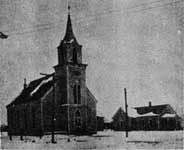
First Church and Parsonage, 19th and Avenue C
Click image to see larger photo.
Rev. Sannquist returned to his field in Kansas and the Kearney Congregation was left without a Pastor for two years. In September, 1886, Reverend J. Torell became the first resident Pastor, after being called by the Nebraska Conference Mission Board. On New Year's Day, 1888, Pastor Torell left Kearney and from that time, the little congregation was without a pastor for twelve years. In 1892, the struggle to pay a heavy debt on the church became too difficult for the few member so they petitioned the conference to take over the church property and the church work in Kearney, which the conference agreed to do.
In light of this condition, the mission board called the Reverend G. Peters for a period of only nine months. During that time, he was able to gather enough funds to pay for the decoration of the church interior and also for much of his salary. After Reverend Peters left, it was only occasionally that some neighboring Pastors could visit Kearney and it was thought by some that the congregation would be dissolved. But, finally, in 1900, the Mission Board succeeded in getting a Pastor for Kearney. They had called the Reverend C. O. Lund who was to take charge after his ordination in the summer of that year. When he arrived on July 6, he found conditions in a very sad state. The congregation now consisted of merely twenty communicant members and fourteen children, according to his own pastoral report, but by January 1, 1901, the membership had increased to 56.
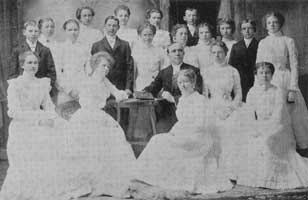
Confirmation Photo - 1901
Click image to see larger photo.
Pastor Lund began at once to gather funds to build a parsonage. (Fig. 1) He was successful, not only in doing this but in paying off the church debt as well. His first confirmation class had twenty members, some of whom received instruction in the Swedish language and the others in English. When he left in 1903, the membership had increased to eighty-five.
At a special meeting held on March 3, 1903, the congregation called the Reverend O. A. Johnson. He accepted, but left in October the following year. For the next two years, services were conducted only on occasions when it was possible to get a theological student from the Seminary in Rock Island, Illinois. Students serving during this period were K. G. Wm. Dahl, who served through the summer of 1904 and who, after his ordination, became the founder of Bethphage Mission at Axtell, Nebraska. Another student serving the congregation was Anders Sandbacka, who served from September 1, 1904 to June 1,1905.
One of the early families that came to this community and selected the Swedish Lutheran Church in which to worship was that of Herman G. Mattson. Mr. Mattson came to the United States in 1904 looking for a place to find work to support his family. He decided on Kearney, Nebraska and in 1905 his wife, Ida Perrsson Mattson left Goteborg, Sweden with their seven children and moved to Kearney. The family of thirteen children were: Ivan, Martin, Herman (Swede), Paul, Marguerite, Henrietta (Boyd), Carl Gunnar, Dr. Arnie M., Ingve (Ding), Larry, Dr. Harold, Caroline (Robinson) and Kathryn.
In 1906, Pastor S. E. Selander was called by the Mission Board on the condition that he spend one fourth of each month with the congregation in Hershey, Nebraska, which had just been organized. In September, 1907, the church bell, a gift from G. H. Lindahl, was installed. A furnace was also installed and the church interior was decorated the same year. Pastor Selander left in the summer of 1910 and was succeeded by Rev. C. G. Bloomquist, who had just been ordained. However, after serving one year, he was forced to leave because of ill health.
Not until 1914 was the congregation able to get a regular pastor again. In the meantime, students were called from Augustana College at Rock Island, Illinois. Among those who served were: Elmer L. Olsen for a year and six months, and Joseph E. Lonnquist, for about nine months.
Then the Reverend Kenneth Bescher came after, his ordination in 1914. It was he who made the first attempt to introduce the English language into the services, but he had little success. The following spring, he left for Hershey, Nebraska, and the Reverend Herman A. Larson became the pastor after his ordination in 1915. For a while, he lived in Minden, Nebraska since he had charge of the Minden and Norman church also. In 1918, these two churches were separated from the Kearney pastorate and the Reverend Larson moved to Kearney and carried on mission work also in Elm Creek, Riverdale, and Hastings. Kearney received $300 aid, and repairs were made on the parsonage. Things looked quite hopeful in 1919; the Sunday school increased rapidly so that there were more children than ever before; another Swedish congregation was disbanded and some of its members came over to us; services were well attended; all evening services were now held in the English language, and the congregation contributed $100 more than the previous year to the pastor's salary. The Conference now contributed $400 in aid. At this time, it was first suggested that the church be moved to a location north of the tracks but it was met with strong opposition. In June, 1920, Pastor Larson and his family left for China, where they served as missionaries for several years.
Dr. C. F. Sandhall, who was conference president and field secretary, served the congregation until September, 1920, when Reverend J. D. Lindberg arrived and served until his death August 1, 1923. When Reverend Lindberg was called, his salary was specified to be $1,800, of which the congregation supplied $900 and the conference the remaining $900.
The Conference Mission Board then called Reverend C. G. Anderson to become field secretary and to have his residence in Kearney. He accepted the call and arrived on September 16, 1923. A special meeting of the congregation had been called to be held on September 19, at which time, the following resolution was adopted: "With reference to the mission in Kearney, the Conference hopes that it (the church) may be situated as soon as possible in a better part of the city, and that the mission may be so conducted that it will be enabled to come in touch with other people besides those of Swedish extraction." Also at this meeting, a committee of three men were elected, which was to make a thorough investigation concerning the moving of the church, the purchasing of a suitable site and that the committee make a report to the congregation as soon as possible. The following committee was selected: A. W. Nelson, Otto C. Olsen and Charles Johnson.
On October 10, 1923, another special meeting was called at which time, the committee gave its report which was immediately accepted. On January 1, 1924, the Mission Board conveyed a quit claim deed to the Congregation for the church property, and it was sold. The Conference had up till that time owned the property for thirty-two years. More members were added to the 'original committee, which was now known as the building committee.
On March 4, 1924, the corner stone of the second church was laid on the new site which was on the south side of East 25th Street between Avenues A and B. An imposing church building was here erected and the property was valued at $21,000. It was dedicated on September 14, 1924 by the Conference president, the Reverend C. 0. Gulleen assisted by the pastors of the Kearney District. Reverend Gulleen was the father of the late Milford Gulleen of this congregation. The church now became known as the First Evangelical Lutheran Church.
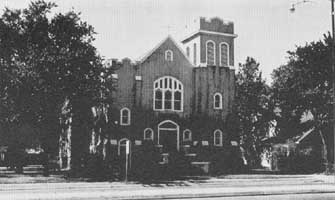
Second Church built in 1924 on East 25th Street between Avenues A and B.
Click image to see larger photo.
It was now decided that all services should be conducted in the English language. Pastor Anderson left in March, 1925, for California. During the following year, the church was served by the following students: Paul Westerburg during the summer and Martin Lingwall from September 1 until February 1, 1926, when the Reverend Ralph Peterson arrived. The congregation was now carrying a debt of more than $11,000 which had been a troublesome problem ever since the new church was built. However, the Conference insisted that the church should go ahead and continue to give aid whenever possible. At this time, the church received $980.00 from the Swan Farris estate, which was applied to the church debt. This came when the congregation was having some very dark days experiencing crop failures, and bank failures, one after another. But the members put forth a greater effort than ever before with several special offerings being lifted. In 1928 and 1929, more than $2,405.00 was collected in this manner.
Pastor Peterson left in September, 1930. After several attempts at calling a pastor had failed, Dr. C. F. Sandahl, who was living in Lincoln and was coming to Kearney each Sunday to conduct the services, accepted the call and moved his family to Kearney as soon as the new parsonage was completed on September 1, 1931. This parsonage was located at 209 East 26th Street.
This period too was not without its difficulties in the life of the Church. The new parsonage added new financial burdens and the "great depression" period had just begun. In order to keep up with the obligations to the Conference and others, it was necessary to borrow more money so things went from bad to worse and the struggling congregation came the point of giving up. Dr. Sandahl, because of ill health, resigned on Easter Sunday, 1937, and left shortly after.
With the help of Dr. C. O. Gulleen, Conference President, who then became vice-pastor, the church managed somehow to get along while they looked for another pastor. Arthur Freburg, a student at Wahoo, helped out during the Christmas holidays and Philip Larson, a theological student helped the following summer. The Reverend Martin Gustafson continued to come for several months from Lincoln each weekend to assist.
Reverend A. F. Carlson, regional director of the Synodical Home Mission Board, arranged for a meeting of the Congregation to be held on July 21, 1939. At this meeting Reverend S. E. Engstrom, Executive Director of Home Missions was present and presented a list of six resolutions. By accepting these resolutions, it was possible to refinance the church's indebtedness through the Home Mission Board and to receive their assistance in calling "a man deemed suitable for this field."
Reverend Carlson then took charge as acting pastor until March, 1940, when Reverend Everett W. Norling arrived. With the financial burdens greatly reduced and a permanent pastor to help, each member seemed to take hold with new vigor and enthusiasm. The membership grew so that within two years it had doubled. It was a sad day when Pastor Norling resigned after two and one-half years and left in October, 1942.
Fortunately, the Rev. A. A. Christensen, Director of Bethphage Mission at Axtell, took over as vice-pastor. He continued to serve until Reverend Walfred Nelson and his wife arrived on September 1, 1943. Improvements, at this time included a new carpet down the center of the church and the building of a new choir loft. A garage was also purchased and moved to the parsonage property at 209 East 26th Street. Now the church was broadcasting a vesper program each Sunday afternoon.
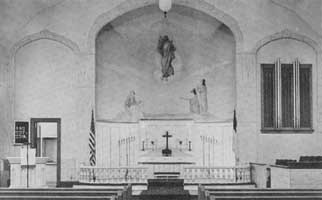
Picture of painting above the altar - church interior
Click image to see larger photo.
In 1945, the parsonage on East 26th Street was sold and the property on the corner of East 25th Street and Avenue B, known as the Hayes property, was purchased for a parsonage at a cost of $8,500.00. The Board of Trustees was now increased from six to nine members. Indebtedness of the church was $7,546.78. Although vesper services were conducted each Sunday over KGFW, one of the local radio stations, the congregation was asked if they would be interested in broadcasting the morning worship service every other Sunday at $17.00 per broadcast. With the help of the Nebraska Conference, this was undertaken. One marked improvement to the church property this year was the complete redecoration of the interior. The painting above the altar, the Ascension, was a source of inspiration to all who looked upon it.
The Nebraska Conference Convention was held at First Lutheran in 1946. Although this meant a great deal of extra work, it was a time for all to rejoice. The new candelabrums and flood lights to emphasize the altar painting were also purchased this year. The indebtedness was reduced to $5,985.17 and a pipe organ fund had grown to $2,147.50.
Pastor Walfred Nelson resigned in May 1947. In December, Pastor and Mrs. Emory Pokrant came to Kearney and assumed their duties at First Lutheran. This was the year in which the congregation realized a dream that extended over a long period of time. The Congregation authorized the Board of Administration to purchase a Reuter Pipe Organ for the church for $3,600.00. It was not installed however, until 1949 with dedication services held on November 20. The final payment on the organ was this year. New monks cloth partitions were hung in the basement so that Sunday School classes could be separated. Also, a new furnace was installed in the parsonage to provide a better and more efficient heating system. Services were now broadcast on only one Sunday each month.
A traditional festivity of the Christmas Season which was an annual event of the Scandanavian countries was also a part of First Lutheran for many years. This was the smorgasbord dinner served by the women. The last such activity was held in 1948 when 625 guests were served an elaborate supper in the church parlors.
The Swedish national colors of blue and yellow were carried out in the decorations of pottery, candles, and festive linens. Walls were ornamented with authentic hangings and articles brought from Sweden and windows held its lighted candles.
Mrs. Frank Lundin as the legendary Christmas spirit of "Lucia" was dressed in a white robe and crown as she greeted the guests at the door. Mrs. John Garner, room hostess, wore a colorful Swedish costume of apron, cap and shawl. The caps and aprons of the waitresses were in yellow and blue.
Four serving tables held the dozens of varieties of food, many dishes made from cherished old-country recipes. As is traditional in a smorgasbord, the artistic arrangements of the food on broad platters was a basic part of the table decorations. One table featured sparkling salads in festive arrangements; another held the hot foods, Swedish breads and relishes; the third was crowded with holiday cookies and desserts. Coffee was served from a silver urn at the fourth table.
Mrs. James Boyd was general chairman with co-chairmen for the three circles assisting her.
Considerable effort was now being focused on reducing the debt of the church. Officers were looking forward to the time when the church would be debt-free. The Ladies Auxiliary gave $1,000 toward this purpose. The men of the church decided, by voluntary efforts, to paint the parsonage. Also during 1950, the men decided to replace the steps in front of the church which had badly deteriorated.
August 22, 1951, was a memorable date for the church. It was at this time that a decision was made which definitely marks growth, progress, and the blessings of God. After 67 years, the Board of Administration felt the church could be self-supporting and did not petition the Board of Home Missions for aid. This was also the first year that the budget plan was used to send the "Lutheran Companion" to every member's home. In addition, the major portion of the cost of broadcasting services once a month were absorbed. It was also necessary to reshingle the roof of the church at this time.
The year 1952 was an historic date in the life of the church. This was the first year the books were closed at the end of the year without any indebtedness or without receiving aid from the Conference and the Synod. By the grace of God and His Will, and the determined efforts of everyone, this goal was finally accomplished.
By the time the festive Easter season of 1953 arrived, the ceiling and walls of the church had been repainted, the floor had been sanded and refinished, and the choir seats had been re-upholstered. In addition, new pews were purchased, installed and dedicated on Palm Sunday without any indebtedness. The congregation was now enjoying success, and making great progress but were sorry to learn that Reverend Pokrant and family were leaving Kearney and moving to Assaria, Kansas.
Following their departure in September, 1953, Reverend A. A. Christensen again came and served as vice-pastor of First Lutheran. The pulpit was supplied by Reverend Theodore Johnson and his staff of faculty members of Luther Junior College at Wahoo, Nebraska for nearly a full year. During this time, unity prevailed among the members of the church and by mid-year of 1954, it was learned that Our Savior had sent another Shepherd.
Immediately after his ordination, Pastor Ronald Ebb and his wife, Gloria, came to Kearney in August, 1954. A year or so later, members of the congregation and officers began talking about the need for more space, particularly due to the over-crowded conditions in the Sunday School with an enrollment of about ninety young people. Several ideas were proposed with a committee appointed to investigate the possibilities of expanding the present facilities. Since the present location of the church was crowded, it did not lend itself to much expansion. In addition, there were noise problems due to traffic on the highway going past the church, safety hazards and a desperate need for parking space so many felt a new location was desirable. However, a partial solution was to acquire another parsonage and use the present one as a Parish House for the Sunday School. This plan seemed to be agreeable and would offer temporary relief.
At the annual meeting in January, 1956, a discussion was held on the need for larger facilities to serve the congregation and the community. Even now, there were four Sunday School classes meeting in the parsonage. At a special meeting of the Congregation on March 23, 1956, the members voted to buy property for the future location of the Church. Several locations were considered. On April 6, 1956, at another special meeting, it was voted and approved to buy a piece of property in the Northeast part of Kearney between Avenues G and H and South of 34th Street. This piece of ground, 295 feet by 345 feet was purchased from Bill Hultman in April, 1956, for $3,500.
The Board of Administration approved a building fund drive which resulted in pledges of $19,500 towards the purchase of property and building of a parsonage. Robert Thorp, Ding Mattson and Elmer Beckmann directed the drive.
In September of 1957, at a congregational meeting, the Board recommended that the present parsonage be converted into an educational unit for use of Sunday School classes, group meetings, etc., and that another parsonage be provided for the Pastor and his family. A committee composed of John Helleberg, Jr., Ding Mattson, Ernie Jensen, Erik Nelson, Herman Larson, L. C. Swanson, and Ed Monson recommended building a new parsonage on a lot 80 feet by 125 feet which was available and later purchased from E. M. Gallemore for $1,250 located at 3320 Avenue G which was across the street from the future church site. After the purchase of this lot, these same men were designated to serve as a Building Committee, with Ding Mattson as chairman, to plan and supervise the building of the new parsonage. A complete set of plans was drawn up by Helleberg and Helleberg, local architects, and given to the church. The bids were let in March, with Charles Stiefvater being awarded the contract. On April 8, 1958 the construction of the new parsonage began and completed so that Pastor Ebb and his family moved in on July 15th, 1958. The cost of the parsonage was $18,604.31. The debt free parsonage was dedicated November 9, 1958 by the District President, the Reverend Clarence Hall. Soon thereafter, the former parsonage, now called the Parish House, was occupied by eight Sunday School classes and the Adult Class on Sunday mornings, with an enrollment of 105 students. The total Sunday School enrollmente was now 178.
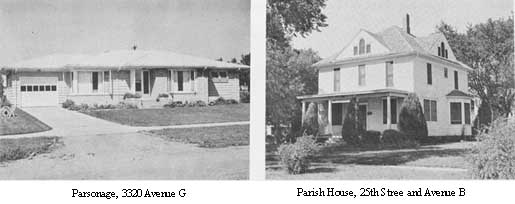
Click image to see larger photo.
The 75th Anniversary of First Lutheran was celebrated on October 16 and 17, 1959. About this time, the new red Hymnals were purchased from memorials, which replaced the badly worn old hymnals. In anticipation and planning for a new church, an additional piece of land at 33rd and G, adjoining the property already owned, was purchased in 1961 for $4,250. An entire square block was now available for a new church in which the congregation could worship. At the annual meeting, Helleberg and Helleberg, local architects, were hired to draw plans for the new church. Also approved at this time was the employment of a Parish worker for the following year. At a special congregational meeting on August 2, approval was given to offer the church property on East 25th Street for sale at $45,000. Membership now totaled 409 adults and 234 children for a total of 643 souls. The church budget was $21,875 with a building fund of $20,137.
During 1963, Miss Gloria Kleven was hired as the first Parish worker. Events taking place the following three years were very special as it marked the time during which plans for the new church with sufficient rooms for Sunday School classes and other activities, adequate parking space, no traffic noise and above all, a beautiful temple in which to worship God were approved and construction started.
It was on November 29, 1964 that a special congregational dinner was held in the dining hall of Kearney State College, to look at and approve the plans for the new church which were designed and presented by the architectural firm of Helleberg and Helleberg. Bids were accepted on the new church in August, 1965 and approved by the congregation on September 5 of that year. The following were appointed to the Building Committee: Kenneth Carlson, chairman; Robert Schroeder, vice-chairman; Harold Forsberg, Otto Olsen and Charles Stiefvater.
Ground-breaking ceremonies were held on September 12 with about 175 members and friends present. Construction began in October, 1965. The cornerstone was laid on July 3, 1966. The property of First Lutheran on East 25th Street was sold to an Oil Company on May 15, 1966. The Parish House was moved to be used as a home, while the Church was razed with only many fond memories remaining.
Since the church property had been sold by the congregation, it was necessary to vacate the property in June, 1966. Final services in the old church on East 25th Street were held on June 19, 1966 with the 11:00 a.m. service broadcast over KGFW radio station. This sanctuary had now served the members of First Lutheran as a house of worship for forty-two years. Arrangements had been made with the Kearney Public Schools to use the gymnasium of Emerson Elementary School to hold regular services and Sunday School. This plan continued for a period of six months from June until the latter part of December.